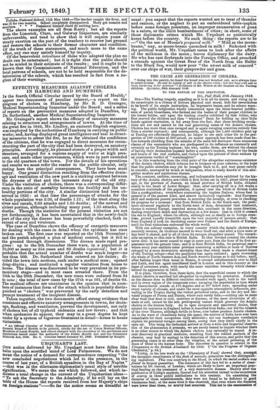EFFECTIVE MEASURES AGAINST CHOLERA IN HAMBURG AND DUMFRIES.
IN the fourth Official Circular issued by the Board of Health,' appear two documents of peculiar interest,—a report on the progress of cholera in Hamburg, by Mr, R. D. Grainger, Medical Superintending Inspector under the Board ; and a series of reports on the preventive measures adopted in Dumfries, by Dr. Sutherland, another Medical Superintending Inspector. Mr. Grainger's report shows the efficacy of sanatory measures relating to structure and arrangements of towns. At the time of the great fire in 1842, Mr. Lindley, an eminent English engineer, was employed by the authorities of Hamburg in carrying on public works; and, having displayed great intelligence and zeal in direct- ing measures to arrest the fire, he so far obtained the confidence of the citizens, that he was engaged to direct measures for recon- structing the part of the city that had been destroyed, on sanatory principles. Accordingly, he planned streets of a proper width and structure, arranged for a copious supply of water at high pres- sure, and made other improvements, which were in part extended ' to the old quarters of the town. For the details of his operations and results we must refer the reader to the public circular, only stating here the principal consequences. They have been most happy. One grand distinction resulting from the effective drain- age and ventilation of the new part is a striking contrast between the dryness of that and the incessant damp of the old city. Under the visitation of cholera, there was a corresponding differ- ence in the ratio of mortality between the healthy and the un- healthy portions of the city. A similar distinction had been ob- served in 1832: at that time the percentage of attacks for the whole population was 2.26, of deaths 1.12; of the tract along the river and canals, 3.63 attacks and 1.85 deaths ; of the newest and airiest portion, although including many poor, 1.25 attacks, 0.65 deaths. Though the statistics for the present visitation are not yet forthcoming, it has been ascertained that in the newly-built part of the city the disease has been powerfully checked, both in extent of area and virulence.
The case of Dumfries shows the efficacy of energetic measures for dealing with the cases in detail when the epidemic has once broken out. The first case was reported on the 16th November ; and the parish adopted a plan of medical control, but it fell to the ground through dissensions. The disease made rapid pro- gress: up to the 9th December there were, in a population of 10,500 as many as 254 cases and 86 deaths registered; but it is probable that the actual number of deaths was much larger—no less than 269. Dr. Sutherland then entered on his duties ; di- vided the town into sections, each under a medical man ; opened drug-depots; and instituted a regular visitation from house to house. The disease was discovered to be very prevalent in its pre- monitory stage—and in most cases arrested there. From the 10th to the 20th December, the new cases were reduced from 34 to none ; the total of new cases by the 27th was 161, of deaths 64. The medical officers are unanimous in the opinion that in num- bers of instances that form of the attack which is popularly distin- guished as " cholera " was prevented by the early detection and prompt treatment of the incipient disease. Taken together, the two documents afford strong evidence that consistent and effective sanatory arrangements in towns, for drain- age, flushing, and ventilation, prevent the development, not only of cholera but of all typhoid endemics and low fevers ; and that when epidemics do appear, they may in a great degree be kept under by a system of vigorous treatment in detail—house to house visitations.
4 An Official Circular of Public Documents and Information : directed by the General Board of Health to be printed, chiefly for the use of Union Medical Officers, Heliffiers of Local Boards, and others charged with Site execution of the provisions and regulations issued under the authority of the Public Health Act and the Nuisances Removal Act, 1848. No. 4. Circular issued January 27, 1849. Published by Knight.


























 Previous page
Previous page